Our stay in the Victoria Falls area was in the Avani Hotel and Resort. This is the main lobby of the hotel.
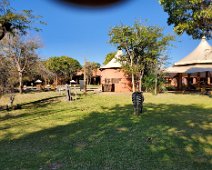
We found that not all the animals on the grounds were sculptures. The hotel is located within Mosi-oa-Tunya National Park which is the smallest reserve in Zambia.
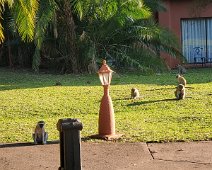
Vervet Monkeys were chased by hotel staff with sling shots to keep them from entering the open air restaurants and stealing food.
As we walked to see Victoria Falls we went past shops where locals sold many kinds of homemade wares. There was also this amusing sign.
In 1855, the Falls was named for the British monarchy by David Livingstone, a British evangelist and explorer. However, African residents in the region referred to it as Mosi-oa-Tunya, which means ‘Smoke that Thunders.’
Between September and December, water levels drop as the flow of the Zambezi decreases. This enables thrill seeker to swim to the edge of the Falls in a naturally-formed pool and view the chasm below.
At sunset on a full moon, the Falls provides a spectacular sight, as the moonlight bounces off the spray giving life to a ‘moonbow,’ which is basically a rainbow that lasts between sunset and sunrise. Unfortunately we were there when the moon was waxing and were not able to see the moonbow, but we did see plenty of rainbows during the day.
David Livingstone memorial at Victoria Falls In the period 1852–56, he explored the African interior, and was the first European to see Victoria Falls (which he named after his monarch, Queen Victoria).
The Victoria Falls waters do not plunge into an open basin but instead, they fall into a chasm that fluctuates in width between 80 and 240 feet.
The time of year greatly influences the character of the Falls. Just two islands emerge at the pinnacle of the falls during the rainy season: Livingston Island and Boaruka Island.
During the dry season, as there is a drop in the flow of the river, a number of more temporary islands will emerge.
The Falls are 354 feet high and 5603 feet wide. Although known as the largest waterfall in the world, it is neither the widest nor the highest. However, it is the biggest curtain of cascading water on earth.
Approximately 172 million gallons of water drops every minute over the cliff at Victoria Falls and continues flowing downstream the lower Zambezi River. That’s the equivalent of 200 Olympic-sized swimming pools, to put things into perspective.
Victoria Falls is one of the Seven Natural Wonders of the World along with Parícutin, Mount Everest, the Grand Canyon, Aurora Borealis, the Harbour of Rio de Janeiro and the Great Barrier Reef.
Originally referred to as the Zambezi Bridge, the parabolic arch design of the Victoria Falls Bridge is credited to George Hobson. It was constructed in England by the Cleveland Bridge and Engineering Company, and shipped to the Mozambique port of Beira, and then railed up to Victoria Falls. In a feat of Victorian engineering, the Bridge took just 14 months to build.
The spray from the falls was tremendous. We had on a short sleeve shirt, a long sleeve shirt, a windbreaker jacket and the blue rain slicker provided by our tour guide and we still got soaked to the skin.
One special vantage point is across the Knife Edge bridge where Sharon can see the full view of the Eastern Cataract.
While the falls are at their highest flow, the formation of the haze or heavy mist can completely obscure the base of the gorge and viewing from a lot of the edge is made challenging.
The functions of the Victoria Falls are not limited only to being an attraction for million of tourists, it is also very important economically. The waterfall supplies energy to several cities in Zimbabwe and Zambia.
Going back across the Knife's Edge Bridge. Sometimes, the mist can be as thrilling as the Falls. Typically, it escalates to more than 1300 feet and it can get to twice that height under certain conditions. Sometimes, the cloud that is formed can be viewed from as far away as 30 miles.
Victoria Falls and the National Parks that surround them in both Zambia and Zimbabwe are classified as UNESCO World Heritage Site. The Falls (and adjacent parks) were inscribed in 1989 because of their ecological and geological value. Both the names of the Falls are fully recognized.
The precipice of the falls forms the chasm, along with a rock wall of the same height on the opposite side. The sole outlet of the chasm is a slender channel cut into some point of the barrier wall.
The Falls feature several principle gorges that range between 400 and 800 feet deep and is among the intricate mysteries of nature.
Victoria Falls has been receding since the last 100,000 years. Initially, it was located 5 miles downstream from its current day position. The basalt rock which is perpendicular to the river’s flow is weak which along with 2 million years’ of erosion have created seven subsequent gorges, which zigzag upstream from the previous one.
This photo provides a great perspective of the shear size of the falls. The road from the bridge is lined with semi-tractor trailers and it doesn't begin to match the width of the falls.
Victoria Falls has no existence without the Zambezi River. The river is 1600 miles long, and the fall lies almost halfway on its path. The Zambezi River flows to the east from the falls and travels through six countries before submerging into the Indian Ocean.
In this photo you can see, right near the end of the rainbow, a small v-shaped crack or divet in the edge of the falls. This is where they believe the next gorge will be cut by the falls, in several thousand years.
Due to the spray from the Falls, the Victoria Falls Rain Forest is the only place on earth that receives rainfall 24 hours a day, 7 days a week.
Members of the Makololo tribe were the ones who actually took the intrepid explorer David Livingstone, in dug out canoes to see the falls.
The towns of Victoria Falls, Zimbabwe and Livingstone, Zambia stand on either side of the mile wide waterfall and the mighty Zambezi River.
A quote from David Livingstone, "No one can imagine the beauty of the view from anything witnessed in England. It had never been seen before by European eyes; but scenes so lovely must have been gazed upon by angels in their flight".
At it's lowest, around late September, October, November and December the falls in Zambia become little rivulets running over the edge and in some places no water falls at all, this is when a dry rock face appears.
We continued our flight downstream over the Batoka Gorge where we experienced the natural beauty of this awe-inspiring dramatic feature, following the mighty Zambezi River, as it carves its way through the steep cliffs.
The Zambezi River below Victoria Falls boasts one of the most spectacular whitewater sections in the world.
The Zambezi River in the Batoka Gorge was first navigated in 1981 and over the years the Rapids were named - some fearsome in nature, others fearsome in name! Such as Between Two Worlds, Stairway to Heaven, The Devils Toilet Bowl, The Gnashing Jaws Of Death to name a few.
Class V is listed as extremely difficult, long, and very violent rapids with highly congested routes, which should be scouted from shore. Rescue conditions are difficult, and there is a significant hazard to life in the event of a mishap. The upper limit of what is possible in a commercial raft.
Another quick flight over the falls and our hotel and then we were off for a flight up the Zambezi River.
Elephants visit the falls to feed on grasses and fruits growing along the banks of the river and on islands in the middle of the river above the falls.
Hippopotamus swim and rest in the Zambezi River upstream of Victoria Falls. They love to eat the swamp grasses growing in the water and along the banks.
Currently there are 123 known species of fish living in the Zambezi River and the Victoria Falls waterfall is a natural barrier that separates them from the upper and lower part of the Zambezi River.
That same day we concluded our trip to Victoria Falls by taking a leisurely sunset cruise aboard the African Queen.
We had the whole bottom floor of the 2 level boat to ourselves. It was here that Staford took great care of us by supplying sundowner drinks and snacks.
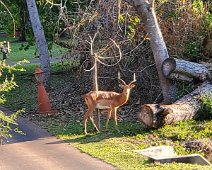
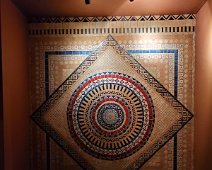
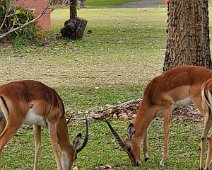
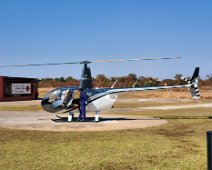

Zambia 1 - Victoria Falls